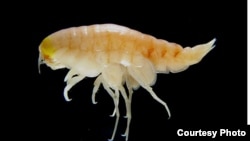No place is safe from pollution, including the deepest parts of the oceans.
Writing in the journal Nature Ecology & Evolution, researchers from Newcastle University in the United Kingdom say small creatures called amphipods that live in the Mariana and Kermadec trenches, both of which are more than 10 kilometers deep, have “extremely high levels” of man-made toxic chemicals in their fatty tissues.
The chemicals, called Persistent Organic Pollutants, include polychlorinated biphenyls (PCBs) and polybrominated diphenyl ethers (PBDEs).
PCBs were produced from the 1930s through the 1970s when they were outlawed. But researchers estimate 1.3 million tonnes of PCBs were produced worldwide.
They entered the environment through “industrial accidents and discharges and leakage from landfills.” Furthermore, they are “invulnerable to natural degradation” so can last for decades.
“We still think of the deep ocean as being this remote and pristine realm, safe from human impact, but our research shows that, sadly, this could not be further from the truth, said lead researcher, Alan Jamieson.
“In fact, the amphipods we sampled contained levels of contamination similar to that found in Japan's Suruga Bay, one of the most polluted industrial zones of the northwest Pacific.”
To reach their conclusions, researchers used deep-sea landers to bring organism samples up from the trenches, which are 7,000 kilometers apart.
The pollutants, according to Jamieson, likely sank to the bottom of the ocean through contaminated plastic garbage as well as dead animals that drifted to the bottom and were eaten by the amphipods. Amphipods with toxic chemicals are then eaten by bigger organisms as the pollutants make their way back into the food chain.
“The fact that we found such extraordinary levels of these pollutants in one of the most remote and inaccessible habitats on earth really brings home the long term, devastating impact that mankind is having on the planet,” said Dr Jamieson. “It’s not a great legacy that we’re leaving behind.”








